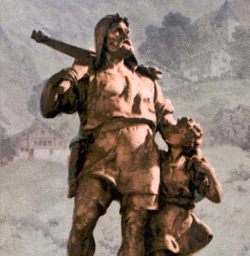The following excerpt is from a fascinating column posted in the September 29, 2011 edition of swissinfo.ch:
Legendary Swiss marksman William Tell is often portrayed as a heroic freedom fighter. But when he killed the Habsburg bailiff, was it not the act of a murderer?
In a new exhibition, the Neuchâtel Art and History Museum takes a provocative look at Switzerland’s mythical hero throughout the ages. State archives also reveal the western canton’s early interest in Tell.
William Tell, a simple peasant from canton Uri, has been reinvented many times over the centuries: saint, legendary figure, mythical being, an apostle of freedom, but at other times a political murderer.
“Tell is an extremely malleable character; he’s ambiguous with all kinds of different faces,” curator Jean-Daniel Morerod, a professor of medieval history at Neuchâtel University, told swissinfo.ch.
Inside the exhibition a larger-than-life statue of the marksman dressed in a yellow-blue-and-red-striped mercenary uniform dating from 1585 prepares to shoot a bolt.
The huge wooden figure used to stand at the entrance of Bern’s arsenal to impress visitors.
“The authorities were proud of the threat that Tell represented at the end of the 16th century,” said Morerod.
